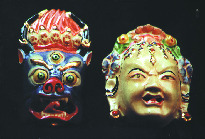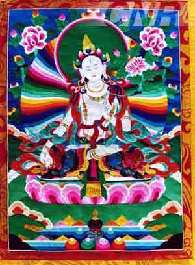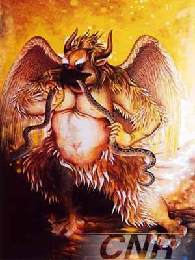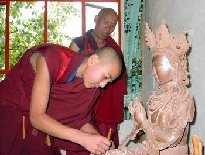Originating in the Wuhe River Valley ofQinghai Province(TongrenCounty of the Huangnan Tibetan Autonomous Prefecture), Regong art is a successful mix of religious art by Tibetan and Tu ethnic minorities and local folk arts. To better protect the art, it was included in the second phase of the National Folk Culture Protection Project in April 2004.
Regong art includes paintings (murals and scrolls called "thangka" in Tibetan), clay and wooden sculptures, barbola, color paintings on buildings, patterns,butter sculptures, and so on. Among these, the paintings, sculptures and designs are most famous.
The contents of Regong art ranges from the story of the Sakyamuni, Bodhisattvas, Buddhist guardians and fairies, to Buddhist stories.
The art -- an important genre in Tibetan Buddhism-- has a history of more than 700 years. It is called " the flower on the Tibetan Plateau" and "a magnifient pearl of Chinese art".
Tongren: Birthplace of Regong art
Along theYellow River to the southeast of Qinghai Province, Tongren County is reputed as the "Home of Tibetan Culture and Art". Tongren, also called "Regong" in Tibetan, is where the art form sprang up along with the rise of Lamaism and the construction of lamaseries, mainly reflecting the Tibetan Buddhist culture.
By the mid-17th century, Regong had become a village where nearly everyone could paint, and every family was engaged in the art. The people of Regong handed down the art from generation to generation, and now almost everyone there is an artisan.
Tongren County has five villages under its administration, where Wutun Village is most famous for its Regong art. In Wutun alone, there are more than 100 Tibetan families of artists. Drawing on the Dunhuang arts, Tibetan painting,garze(in Sichuan) woodcarving and Tibetan folk art, the families have formed their own particular style.
Their works cover a wide range from color paintings, sculptures, designs, butter flowers, embroidery, brick and stone carvings and architectural decorations. Apart from murals, Wutun artists are also known for theirthangka-making and woodcarving. The skillful application of gold powder, cinnabar and azurite gives their paintings a strong decorative effect.
Wutun artists are well known not only among Tibetan and Mongolian Buddhist clergy but also in India and Nepal.
Characteristics of Regong art
In the early period, Regong artworks were crude and unsophisticated with monotone colors, featuring typical Indian and Nepalese styles. In the mid-17th century, artisans mastered better techniques and the painting styles became more elegant and exquisite; they also paid more attention to decorative effects in their works. Thus, the art entered a prosperous period of development.
After the 19th century, Regong artworks featured beautiful colors and an exquisite touch. The artisans of this period paid special attention to the decorative interest in their works and employed a great amount of gold to make the works resplendent and magnificent, creating an ardent atmosphere. The works not only look harmonious in their arrangement of different subjects but are also lifelike and lively, displaying outstanding artistic effects.
Over the past several centuries, Regong art artisans traveled to many different regions to create different works, such as Qinghai Province,Tibetan Autonomous Region,Gansu Province,Sichuan Province,the Inner Mongolian Autonomous Regionand other places in China, as well as India, Nepal, Thailand, Mongolia and other countries in the world, leaving behind numerous exquisite art works. They assimilated artistic nourishment from Tibetan paintings,Dunhuang muralsand foreign similar works and then combined them with local folk arts of Qinghai Province to gradually consummate the techniques of Regong art.
The unpretentious painting style, even and harmonious color arrangements and realism of Regong artworks fully reflect Tibetan culture, making the art a curiosity hard to come by in China's cultural heritage.
Major types of Regong art
Barbola:This is a special art that employs the techniques of "cutting" and "piling" to portray objects. In terms of specific techniques, barbola can be subcategorized into "jian dui" (literally, to "cut and pile") and "ci xiu" ("embroidery"). The barbola works in Regong are mainly of the jian dui style. To make jian dui barbola, artisans select silks and satins of different colors according to type of expression desired, cut them into human, animal, flower and bird shapes of a certain size, and then paste the patterns onto the pre-cutpaper models. After that, they are stacked from dense to light colors. Since the middle of the barbola is slightly convex, the work creates a strong three-dimensional effect that looks like a colored embossment made of silk material. Barbola subjects generally come from Buddhist stories, and most of them are about people. Barbola pays much attention to posture and the details of human figures, and values the arrangement of silks and satins of different colors. It features an exquisite touch amid roughness, gives prominence to its major subjects, has vivid colors and forms a strong contrast. Barbola is an innovation in embroidery art, combining embroidery and embossment.
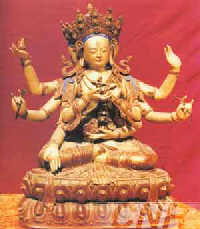
Sculpture:Sculpture, which holds an important position among Regong art, mainly includes clay sculpture, woodcarving, brick engraving and so on, where clay sculpture is the most popular. The art of clay sculptures had matured from the mid-17th century to the early 19th century when the sculptures were exquisitely carved and were lifelike, with smooth clothing lines, a sense of reality and a strong contrast in colors that were arranged harmoniously. The clay sculptures in Regong were combined with templearchitecture to express the wide-ranging contents related to the architecture. The range of subjects is also very wide. Besides the sun, moon and stars, mountains, flowers and trees, birds, beasts, fishes and worms and other patterns used as decorations and foils, different colors and other various images also appear in sculptures. These include the bizarre motley Buddhist guardians, Buddha's warrior attendants with horrifying features, horse-headed and red-haired gods, and so on.
In addition, woodcarving and brick engraving can also be found in many places. Woodcarving is mainly employed to make decorative patterns on door lintels and chapiters of a house, as well as wooden josses. Brick carving is mainly seen in such forms of architecture, as decorative patterns,dragons and phoenixes and pairs of lions on the ridge of a house, beasts on flyingroofsand basso reliefs on walls.
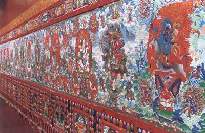 |
| The painting scroll of "Magnificent Spectacle of Color Paintings About Chinese Tibetan Culture and Arts" (part) " |
With a length of 618 meters and a width of 2.5 meters, it is the longest painting scroll in the world. The whole scroll covers more than 1,500 square meters and weighs over 1,000 kilograms. Its contents involve the history, culture, folk customs and arts of theTibetan ethnic minority, including the formation of the world, the origin of the Tibetan ethnic minority, past Tibetan kings, the story of Sakyamuni, different sects of Tibetan Buddhism, historical celebrities, medicine, astronomy, literature, architecture, as well as scenic spots and historical sites in Tibet, festival scenes, costumes, articles for daily use, weapons, decorative patterns, and so on. Thus, it can be regarded as the encyclopedia of Tibetan history and culture.
All of the pigments used to paint the scroll come from the nature, such as the mineral pigment made from gold, silver, coral, agate, pearl and diamond, and plant pigments made from saffron, madder and rhubarb.
Inheriting the techniques of traditional Tibetan paintings, the work also assimilates the skills used in western paintings, bringing viewers a new and fresh aesthetic experience. The whole scroll features an exquisite touch and depicts many lifelike human figures. The densest places on the scroll contain more than 300 human figures or 30 palace rooms per square meter -- that's more than 2,480 mural images on each square inch, which can only be achieved using a brush with a neb of a single hair. Many subminiature images can only be detected with the help of a magnifying glass.
After its completion in August 1999, the scroll made its debut in the Longxing area of Huangnan Prefecture in Gansu Province from September 30-October 4 that year. In the same year, the work won the "Record of the Great World Genesis."
Regong art propels economic development of Tongren
As the nation's historic and cultural city, Tongren came up with the idea of combining culture and economy to develop both fields. It considers Regong art as a top resource to promote its tourism and expand publicity efforts to boost its fame. Every year, more than 3,000 tourists from the United States, Japan, Britain, Australia, Switzerland and other countries come to Tongren to appreciate Regong art and many travel fromTaiwanand Hong Kong regions for the same purpose.
Meanwhile, to maximize the local economy, Tongren set up the Regong Art Association to ensure the orderly and healthy development of Regong artwork markets.
It is reported that in Upper Wutun Village more than 90 percent of adult men and many women have mastered the skills of makingthangkaand sculptures. As a result, many of them are invited to Inner Mongolia, Sichuan, Zhejiang, Tibet and Gansu to create painting and sculptures while others stay behind to produce them at home. Each year the per-capita income of people in the village exceeds 2,500 yuan, with more than 80 percent coming from Regong art works. Rough statistics show that in Tongren County the annual revenue from Regong art reaches more than 36 million yuan, accounting for 2.1 percent of the total.

